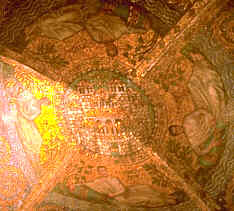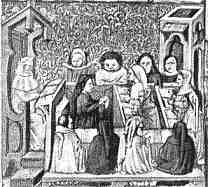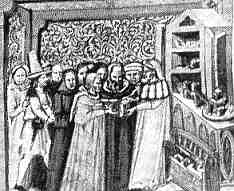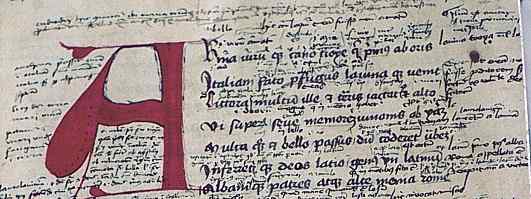





If you are looking at this page without frames, there is more information about medieval writing to be found by going to the home page (framed) or the site map (no frames).
| The Private Ownership of Books | ||||
| The concept of literacy as a prerogative of monks, and of libraries as belonging exclusively to monasteries, is something of a cliché of the medieval world. Certainly, for many centuries, the monasteries were the cradle of literacy and the most significant book owners, but the private ownership of books spread progressively through the upper and middle classes during the course of the later middle ages. It is interesting, but perhaps difficult, to try and investigate just what kinds of books they owned, and what they valued. | ||||
 |
Aristocrats were known to have been book owners in the Carolingian era, although Christopher de Hamel (de Hamel 1986) has suggested they were valued more as booty for their gilded appearance than as works of literature. Nevertheless, part of the Carolingian ethos was the valuation of the values of the Roman Empire, which included literacy. The ownership of books could be valued in different ways; as symbols of status and power, as symbols of learning. Among the many largely illiterate societies of Europe, including the Anglo-Saxons, it seems the valuation of book ownership among the laity was much later in coming. | |||
| A golden mosaic ceiling in Charlemagne's Palatine Chapel in Aachen. | ||||
| For many centuries the monasteries were the builders of libraries, but the remoteness of the age and fragility of the evidence makes it difficult to trace exactly how these libraries were accumulated. The trails are cold on who were the original owners of the books which were rescued from obscurity by being copied and recopied in monastic scriptoria. If some were rescued from the private libraries of ancient bibliophiles, then the evidence for it is lost forever. | ||||
| Although the books in monastic libraries were of communal ownership, wealthy and learned senior churchmen may have contributed personal copies of books either as exemplars for copying, or directly into monastic libraries. By the 12th century or so, there was a flurry of tidying up the texts which were in use for the liturgy. Old variants of the Psalms or other Bible texts were being replaced with the Vulgate of St Jerome, which had, of course, been around for many centuries but which the church had decided must be the authorised version fo the text. Bishops and abbots presented fine copies for use as exemplars. Senior churchmen had private libraries, which may have sometimes ended up as part of the communal library of a community. | ||||
 |
||||
| List of books belonging to Simon Bozoun, prior of Norwich, in an early 14th century volume of historical and topographical works (British Library, Royal MS 14 C xiii, f.13b). (From New Palaeographical Society 1908) | ||||
| The above image shows the first three entries in a list of 31 of the private library of Simon Bozoun, prior of Norwich. The list is plonked into the middle of a volume of mixed works of history and of travel. The list itself documents various theological works and chronicles, each listed with their monetary value. The list is in a neat book hand, and is not just a scribbled annotation. The book containing the list is evidently itself listed. I guess you can make your own mind up about what is going on here, but it looks like a big pile of books is in the process of being handed over from a private clerical library to an institution, perhaps to ensure that an elderly, retiring prior had lodging and a pension. (Hey, that is speculation and therefore wicked, but plausible.) | ||||
| The eminent theologians who shaped the thinking of the church presumably did not have to go and consult chained books in the library for their researches as the most literate end of the church continuum became steadily more scholarly. With the advent of the universities, doctors and students alike required books for their individual use. | ||||
 |
At left, a teaching scene from a manuscript miniature (Bibliothèque de Cambrai). (From Lanson 1923) | |||
| University teaching in the middle ages was entirely book oriented. There were no chatty tutorial discussions. Numerous manuscript miniatures show the teacher at the head of the class with an open book, reading from it. The students each have their own copy of the text open in front of them and are following the words that are being read to them. The master had his own private library, and so did the students. | ||||
| Miniature of a bookseller in a manuscript from the Bibliothèque de Cambrai. (From Lanson 1923) |  |
|||
| Booksellers thrived in the university towns, providing for the needs of senior scholars, students and the communal libraries of colleges. These were not necessarily fancy illuminated volumes with high production values, but simple working copies, many of which have undoubtedly now succumbed to the ravages of time. | ||||
| In some cases students wrote out their own books, hiring the exemplars section by section from the stationers in the process known as the pecia system. In other cases they copied them out by dictation in class in crabbed, abbreviated scripts. Interestingly, they did not use a special shorthand for this. For example, the script used for writing law texts at the University of Bologna, a tight and heavily abbreviated version of Gothic rotunda, is known as littera bononiensis. The example below is a very neat example of the type, obviously not scribbled out in a lecture. | ||||
 |
An example of littera bononiensis from a 14th century work of Johannis Andreae Novella on the Decretals (Vatic 1456, v.f.179). (From Ehrle and Libaert 1932) | |||
| Student texts were also annotated, or glossed, so that they provided their own commentary as well as the basic text. This is very much in accord with the whole medieval concept of text, which tended to be cumulative. Where such works survive, they appear messy and dense to our eyes accustomed to the niceties of printers' layout. The example below, which may well be a student text, shows tiny annotations in a spidery cursive hand all over and through the main text, which is in a German Gothic cursive book hand. Even the decorative initial is festooned with little notes. A single book was not just a book, it was a library. | ||||
 |
||||
| Segment from a 15th century German copy of the works of Virgil from the University of Tasmania Library, by permission of the University of Tasmania Library. | ||||
| Despite the fact that these university manuscript books may not have been the most glamorous of editions, they were articles of value. Books could be used as collateral for loans, and some colleges held books for this purpose in special chests. If the owner defaulted on the loan, the college acquired the book and it went around again. There was also a trade among the university booksellers in secondhand books. They were such laboriously produced works that even the most modest examples had value. | ||||
| Meanwhile, the more wealthy and aristocratic members of the laity were becoming more literate, and were developing their own reasons for owning libraries of books. | ||||
|
|
||||
|
If you are looking at this page without frames, there is more information about medieval writing to be found by going to the home page (framed) or the site map (no frames). |
||||